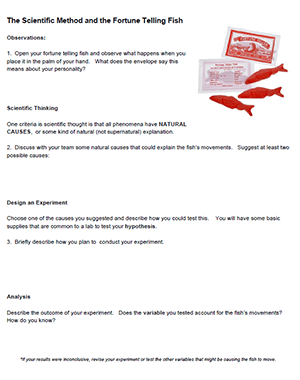
This activity is perfect for a first day or as an introduction to the scientific method. Though there isn’t quite as much cooperation as the “Saving Sam” activity, the fortune telling fish allows students to explore the nature of science together.
The handout linked can be given to students, or you can also project them or just have students to the activity in an informal way. Sometimes, students come to our classroom with a concept that experiments in science include specific instructions, and few students are exposed to the idea of science as exploration.
In this case, students put the fortune telling fish in their hands and it will curl. The sleeve contains some personality information about what the movement means. Students play with the toy and then propose natural explanations for the fish’s movements. They will usually come up with things like the warmth of the hand, or moisture on the hand.

Students are then asked to design a way to test their hypothesis. Here, you can use things you might have available in a lab, like water and paper towels. For students that propose it’s heat, I borrow the lizard’s heating pad for testing.
The cellophane that the fish is made from is actually hydroscopic, so it absorbs sweat or moisture from the skin. When the cellophane absorbs the moisture, it causes it to swell and curl away from the palm.
Depending on your students, you may need to give them guidance and leading questions, but overall, the goal is to get students to look at science as a way to answer questions and explain things we observe. NGSS lessons will use the word “phenomena” to guide a lesson where students build their understanding by exploring some kind of phenomenon observed in the world.
Fortune Telling Fish are cheap to purchase on Amazon.

